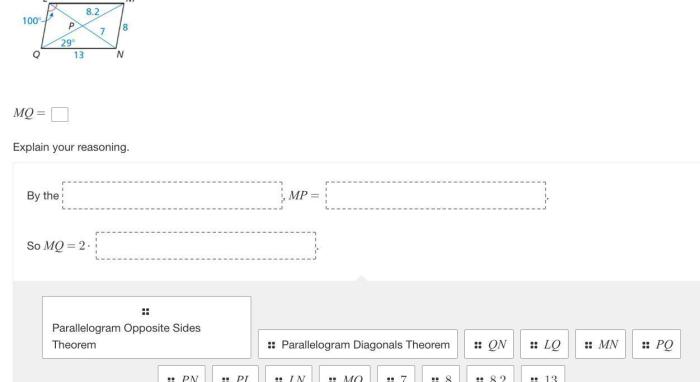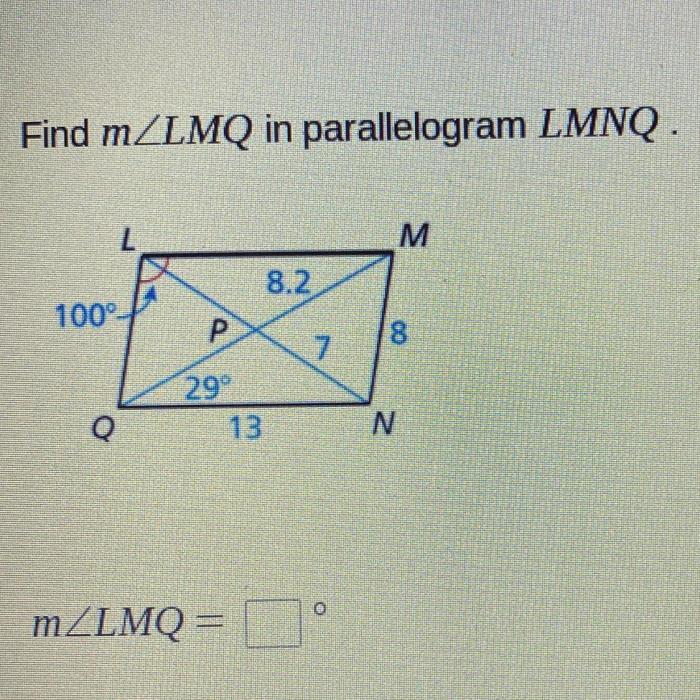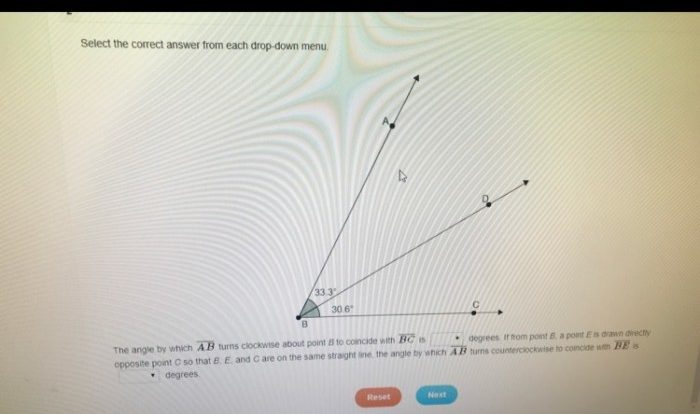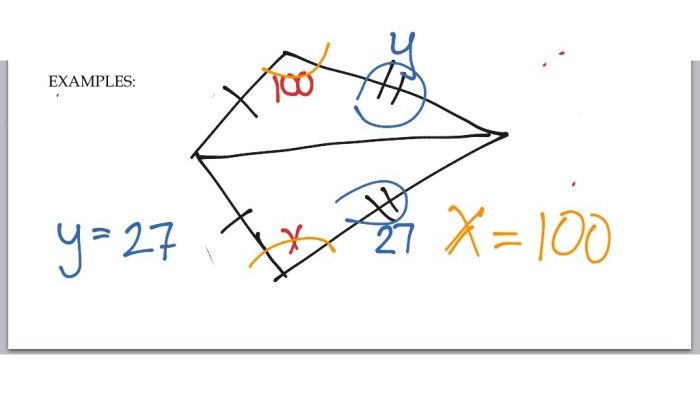Embark on an intriguing journey to find MQ in parallelogram LMNQ. This geometric exploration will delve into the fascinating world of parallelograms, revealing the secrets behind their unique properties and the significance of MQ within their structure. Prepare to be captivated as we unravel the mysteries surrounding this enigmatic side and its profound impact on the parallelogram’s overall characteristics.
Through a blend of intuitive explanations and visual representations, we will illuminate the concept of a parallelogram, its key features, and the distinctive role played by MQ. Join us as we embark on this intellectual adventure, unlocking the secrets of MQ in parallelogram LMNQ.
Definition of Parallelogram

A parallelogram is a quadrilateral with two pairs of parallel sides. The opposite sides of a parallelogram are equal in length, and the opposite angles are equal in measure. Parallelograms are classified as a type of quadrilateral, which is a polygon with four sides.
The key characteristics of a parallelogram include:
- Two pairs of parallel sides
- Opposite sides are equal in length
- Opposite angles are equal in measure
- Diagonals bisect each other
Here is a visual representation of a parallelogram with labeled sides and angles:

Identifying MQ in Parallelogram LMNQ

In a parallelogram, opposite sides are parallel and equal in length. To identify MQ in parallelogram LMNQ, we need to understand the relationship between the sides.
Distinguishing MQ from Other Sides
To distinguish MQ from other sides of the parallelogram, we can use the following steps:
- Identify two parallel sides of the parallelogram. Let’s say LM and NQ are parallel.
- Since opposite sides are equal, LM = NQ.
- MQ is the side opposite to LN. Therefore, MQ = LN.
Hence, we can conclude that MQ is the side opposite to LN in parallelogram LMNQ.
Relationship between MQ and Other Sides

The length of MQ is closely related to the lengths of the other sides of the parallelogram LMNQ.
Opposite Sides in a Parallelogram
In a parallelogram, opposite sides are equal in length. This means that:
- LM = NQ
- LN = MQ
Therefore, since MQ is opposite LN, we can conclude that:
MQ = LN
Properties of Parallelogram Related to MQ

The side MQ in a parallelogram possesses unique properties that influence the shape’s overall characteristics.
One crucial property is that MQ is parallel and congruent to LN. This parallel relationship implies that MQ and LN never intersect and are equidistant, maintaining the same distance throughout their lengths.
Congruency of Opposite Sides, Find mq in parallelogram lmnq
In a parallelogram, opposite sides are congruent. Therefore, MQ is congruent to LN, meaning they have the same length. This congruency ensures that the parallelogram’s shape is balanced and symmetrical, with two pairs of equal sides.
Parallelism of Opposite Sides
Another essential property is that opposite sides in a parallelogram are parallel. Thus, MQ is parallel to LN. This parallelism ensures that the parallelogram’s shape is uniform and non-skewed, with opposite sides running in the same direction.
Equal Area of Opposite Triangles
The presence of MQ in a parallelogram also leads to the formation of two congruent triangles: LMQ and NQM. These triangles share MQ as a common side and have equal base lengths (LM = NQ) due to the congruency of opposite sides.
To find the length of MQ in parallelogram LMNQ, you can use the formula MQ = LN – NQ. For more practice with geometry problems like this, check out the en espanol 1 workbook answers . The answer key provides step-by-step solutions to various geometry problems, including finding the length of a segment in a parallelogram.
Consequently, the areas of these triangles are equal.
Applications of Identifying MQ: Find Mq In Parallelogram Lmnq

Identifying MQ in a parallelogram has various practical applications in geometry and beyond. Understanding the relationship between MQ and other sides of the parallelogram enables us to solve geometry problems, calculate areas, and explore other mathematical concepts.
Applications in Geometry
- Finding the Perimeter:Knowing MQ allows us to calculate the perimeter of the parallelogram. Since opposite sides of a parallelogram are equal, we can use MQ to find the length of other sides and then add them up to get the perimeter.
- Calculating the Area:The area of a parallelogram is given by the product of its base and height. By identifying MQ as the base and another side perpendicular to it as the height, we can easily calculate the area of the parallelogram.
- Proving Congruence:In geometry, proving the congruence of figures is essential. By showing that the corresponding sides and diagonals of two parallelograms are equal, including MQ, we can establish their congruence.
Applications in Other Mathematical Contexts
- Vector Analysis:In vector analysis, parallelograms are used to represent vectors. Identifying MQ as a vector can help in vector addition, subtraction, and other operations.
- Linear Algebra:Parallelograms play a role in linear algebra, where they are used to represent matrices. The length and direction of MQ can be used to determine the properties of the corresponding matrix.
FAQ
What is the definition of a parallelogram?
A parallelogram is a quadrilateral with two pairs of parallel sides.
How can we identify MQ in parallelogram LMNQ?
MQ is the side opposite to LN in parallelogram LMNQ.
What is the relationship between MQ and the other sides of the parallelogram?
MQ is equal in length to LN and parallel to LP and NM.
What are some practical applications of identifying MQ in a parallelogram?
Identifying MQ can help in solving problems related to area, perimeter, and other geometric properties of parallelograms.

